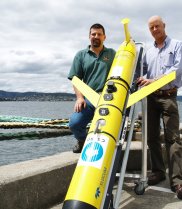Predicting Australia’s future marine environment with state of the art models
Coastal models have been used to investigate and predict the water quality in coastal bays, gulfs, harbours and river estuaries such as Moreton Bay and the Derwent. “These models have been in development for the past 20 years but we know they contain approximations, and therefore uncertainties that we are working together to quantify and reduce,” said workshop coordinator, Dr Emlyn Jones from CSIRO.
These models are crucial for sustainable development of coastal and marine resources and industries because management scenarios often involve pushing systems beyond the limits for which observations are available, such as climate change impacts.
Other applications of marine biogeochemical modelling extend from understanding the effects of aquaculture on water quality in southern Tasmania, to the fate and impact of carbon dioxide in the Southern Ocean and Great Barrier Reef, and to the ability of Australia’s coastal and marine wetlands and seagrass meadows to sequester and store atmospheric carbon dioxide.
Dr Jones said modelers are heavily reliant on working with observations made through coastal monitoring programs such as Australia’s Integrated Marine Observing System.
“Measurement of the marine environment is at the heart of this work but we are limited to only sparse observations. Thus, we are working to predict future behaviour and give precise estimates of confidence in these predictions.
“Everyday, we see the need to harness our observations and project them into a future scenario for use by environmental managers.
“Given that we cannot observe the future, models must be used to make such predictions of future system behaviour. Harnessing all available data, often from different and non-uniform sources, we can trial and test management scenarios and accommodate the uncertainties,” Dr Jones said.
It also takes a lot of computation. CSIRO models are run on its supercomputer Bragg, one of the fastest 200 machines in the world*. Bragg uses graphics processing units (GPUs), originally designed for computer games, to accelerate scientific computations. Even then the models can take hours or days to run. One of the aims of the workshop is to deliver results faster, not just improve the quality of the results.
Dr Jones said the workshop hoped to identify new approaches to estimate uncertainty leading to a formula useful for reviewing, forecasting and long-term prediction in marine ecosystems.
These models are crucial for sustainable development of coastal and marine resources and industries because management scenarios often involve pushing systems beyond the limits for which observations are available, such as climate change impacts.
The workshop is being funded by the CSIRO Office of the Chief Executive, CSIRO Computation and Simulation Sciences Transformational Capability Platform and the Wealth from the Oceans Flagship.
Media resources
Click image for high resolution version


